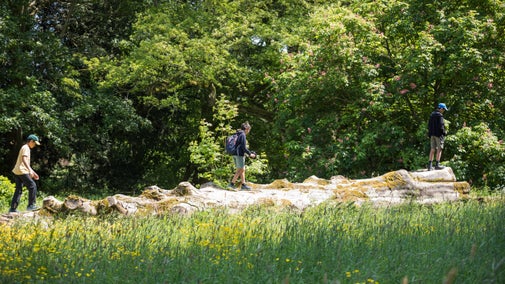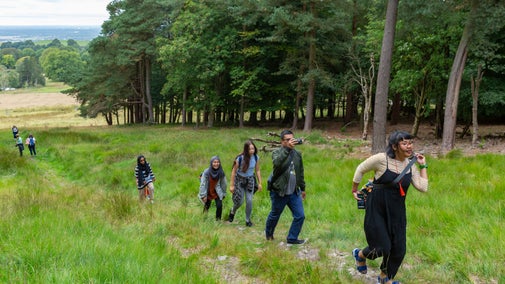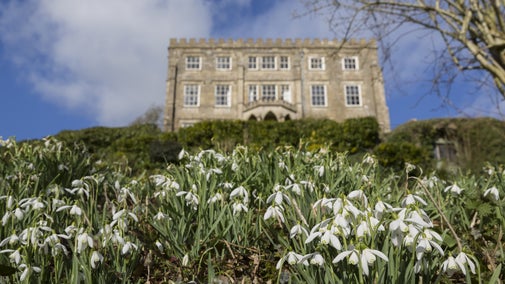
Discover Minchinhampton and Rodborough Commons
Find out how to get to Minchinhampton and Rodborough Commons, where to park, the things to see and do and more.

Minchinhampton and Rodborough Commons are home to some interesting wildlife. The areas are of international importance thanks to their limestone grassland and the rare and diverse species that can be found there. They're two of over 4,000 places in England designated as a Site of Special Scientific Interest. These areas are sensitive and are important for conservation of flora, fauna and geology.
The Commons lie within the Cotswolds’ Area of Outstanding Natural Beauty. Rodborough Common has a particularly rich flora and fauna and has been given additional European protection as a Special Area of Conservation.
More than a hundred species of grasses and wildflowers have been recorded, including rare orchids and over 30 species of butterfly.
The distinctive habitat on the Commons makes it perfect for butterflies, birds, adders and wildflowers. Many different types of butterfly can be found on the Commons between April and July, which are the best time of year to spot some of the rarer species.
A wide variety can be spotted during the warmer months, from the eye-catching green hairstreak to the rapidly declining Duke of Burgundy butterfly. The commons is home to one of the largest populations of the rare Duke of Burgundy butterfly in the country. Some, like the small blue and brown argus butterflies, prefer the heavily grazed areas where the grass is shorter while others prefer the longer grass on lightly grazed areas. This is the ideal habitat for the ringlet and marbled white butterflies.
The green hairstreak butterfly is the only green coloured butterfly in the UK. It prefers the thick soils and lightly grazed areas on the non-southerly facing slopes on the Commons.
The Duke of Burgundy butterfly is now a priority species for conservation. Its falling numbers are making it more and more difficult to spot. Living in small colonies, it prefers areas of taller grass. The scrubby grassland on the common is ideal as the Duke of Burgundy rarely visits flowers. You may see it perching on leaves at the edge of the scrub.
There's also an abundance of wildflowers growing in the area. During the summer you may see orchids and other wild plants flowering between June and July.
The bee orchid gets its name from its main pollinator. In order to attract pollinating bees, the plant has evolved bee-like flowers. The bee orchid can be found on the south facing grasslands on the Commons that have been tightly grazed by the cattle. Their survival relies on the cattle disturbing the ground.
You can see the carline thistle on the Commons between July and September. The dead heads can be seen for much longer, sometimes right through to the following spring.
The short, stiff and spiny carline thistle is important to the adonis blue butterfly. Despite looking like its gone seed, the distinctive brown and golden flower heads are actually in full bloom.

It was only a few decades ago that the sky above the Commons would have been filled with the singing of skylarks. Sadly, although they can still be heard, their number has fallen. They build their nests on the ground making them prone to being disturbed easily.
The unique and varied habitats on SSSIs (or a Site of Special Scientific Interest), and the important wildlife they support need very careful management. Cattle graze at certain times of the year, helping to create swards of different lengths.
Although an important habitat, if left unmanaged scrub can be invasive. We remove areas where it's encroaching onto the fragile grasslands.
We all have a part to play in helping to protect the commons and other Sites of Special Scientific Interest. It's an offence to intentionally or recklessly damage or destroy these areas and to disturb the wildlife. Help us to keep the commons special during your visit by taking care not to cause any damage.
In the Middle Ages, the use of land was governed by the manorial system. Food was grown, animals grazed and fuel was gathered. Land remained under the ownership of the Lord of the Manor, but some local people were given the right to use the poorer quality areas which became known as 'common land'.
Today, these 'rights of common' at Minchinhampton and Rodborough include the grazing of animals known as 'herbage' and taking dead or brash wood, gorse or furze called 'estovers'. The people who can exercise these rights are known as 'commoners' because they own property within the historic Manor. These rights are usually recorded in the household deeds, and in the Commons Register held by Gloucestershire County Council.
Minchinhampton and Rodborough Commons are classed as 'urban commons'. This means that people have a right of access for 'air and exercise' and for the enjoyment of the area. The commons also include some smaller commons including Hyde, Besbury and St. Chloe Green Commons.

Find out how to get to Minchinhampton and Rodborough Commons, where to park, the things to see and do and more.
Learn how the National Trust works in collaboration with the Minchinhampton and Rodborough Commons Advisory Committee to protect and conserve these areas for everyone, for ever.
Discover more about the conservation work at Minchinhampton and Rodborough Commons, in the Cotswolds. Learn how a rare blue butterfly made its return to the area.

Across Gloucestershire, we’re working as part of the Stroud landscape project, aiming to reverse the decline of rare wildlife species including the Greater Horseshoe bat.
Join us for a free event to find out why Marking Day on 18 May is such an important day of the spring season and how the tradition has been revived in recent years.

Plan a visit to one of the special countryside places in our care and discover the benefits of being in the great outdoors. Pack your walking boots and get ready to explore woodlands, valleys and rivers.

Explore some of the finest landscapes in our care on coastal paths, accessible trails, woodland walks and everything in between. Find the best places to walk near you.

There are plenty of things to do in Gloucestershire and the Cotswolds, from visiting historic gardens, to exploring houses and ancient sites amongst a patchwork of commons, woods and valleys. Start planning your visit for all the family to enjoy.
